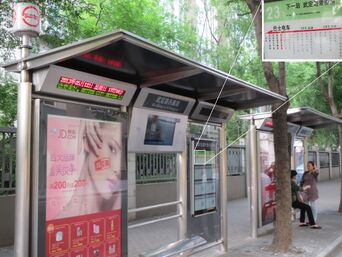Shanghai's bus system is vast, with around 1,000 different routes served by more than 10 different bus companies. Although taking the bus in Shanghai may appear to be a daunting prospect to the uninitiated foreigner, it is very cheap and extremely convenient once you know which bus routes work best for your needs.
In the outlying parts of Puxi and Pudong, buses are integral as metro stations in less developed areas are far more sparse than they are in the centre. However, do not discount the convenience of buses in the centre of the city, as they can often get you from A to B faster than the metro or a taxi, and for less money.
Of the more than 300 trolleybus systems in operation worldwide (as of 2011), the Shanghai system is the oldest.

A typical Shanghai bus stop. Note the bus route number (e.g. route #23). Not all bus stops will have an awning; some are composed of little more than a post in the ground with the bus route number and list of stops.
Bus stops can be found almost anywhere in the city, but require Chinese character recognition to navigate when on the street. Names of bus stops are not always indicative of where an actual stop is located; it is recommended to check a Shanghai bus mapping website beforehand as listed below so that when you are riding it's clear where to alight. Use plug-ins such as Google Translate for Chrome or online dictionaries such as nCiku as required.
Bus stops are written vertically from left to right, with all bus stops on a given route listed. An arrow points from left to right (or vice versa) indicating which direction to read to sign, with greyed-out characters denoting stops that have already been passed. If you're going in the wrong direction simply cross the street and find the nearest bus stop going in the opposite direction to get back on track.
Those with limited Chinese can use Google Maps to plan their journey as the "public transit" directions do include Shanghai's bus routes. It also conveniently marks every bus stop location with an icons that can then be clicked on for detailed bus route info.
For a more detailed guide, check out Mob_King's thread here for how to plan out a bus route beforehand using the Chinese website ddmap.com.
Tickets and pricing
As of January 2013, you can pay the bus driver using coins, notes, or your trusty transport card, unlike Beijing which still has a dedicated ticket-seller aboard each bus.
If you pay cash, make sure you have the right amount, because the bus driver doesn't have to give change. Drop your money into the receptacle as you pass by the driver.
Standard fare for an air-conditioned bus is 2 RMB.
Popular bus routes
Xuhui
Jing'an
Railway station
Pudong airport buses

The Pudong Airport bus route list
Buses leave Pudong airport every 15 minutes or so, collecting passengers at the bus stop at T1 before moving on to T2. Stash suitcases below and climc aboard; a lady selling tickets will find you. Prices vary and go as high as 22 RMB if it's a direct route.
Useful lines include Line #1, (Hongqiao airport), Line #2 (Jing'an) and Line #5 (Shanghai railway station). Here is a link to the whole timetable.
Etiquette
When riding the bus, international public transport rules generally apply, and even though relatively few locals follow these guidelines all the way through, we recommend you practice good public transport etiquette:
- board through the front door and alight from the back door
- allow passengers to alight before boarding
- give up your seat to pregnant women, the elderly, disabled etc.
- it's increasingly popular to wear a mask on public transport as a courtesy if you're displaying flu or common cold symptoms
It's fine to ask the driver to help you if you're not sure where you need to alight.
A common Chinese tactic is to sit on the outside aisle seat and leave the inside window seat empty, especially when the inside seat has less leg space due to the rear bus wheels protruding. It also discourages people from taking the empty seat as you have to clamber over them to get to it.
Laowai Lingo
- 公交车 or 公共汽车 - gōngjiāochē or gōnggòngqìchē - bus
- 车站 - chēzhàn - bus stop (NB: also means 'railway station' and is highly contextual; use together with 'bus' to clarify)
- 23路车站在那儿? - èrshísān lù chēzhàn zài nǎr? - Where is the route 23 bus stop?
- 这路车到……吗? - zhè lù chē dào …… ma? - Does this bus go to ... ?
- 到……的时候 麻烦你告诉我一下 - dào …… de shíhou máfan nǐ gàosù wǒ yíxià - Please tell me when we get to ...